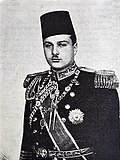Farouk of Egypt
Farouk I (/fəˈruːk/; Arabic: فاروق الأول, full name: Farouk bin Ahmed Fuad bin Ismail bin Ibrahim bin Muhammad Ali bin Ibrahim Agha; 11 February 1920 — 18 March 1965) was the King of Egypt and the Sudan from 1936 until his abdication in 1952.
| Farouk I | |||||
|---|---|---|---|---|---|
 Farouk in 1946 | |||||
| King of Egypt and the Sudan | |||||
| 28 April 1936 — 26 July 1952 | |||||
| 29 July 1937 | |||||
| Predecessor | Fuad I | ||||
| Successor | Fuad II | ||||
| Regents | |||||
| Prime Ministers | |||||
| Head of the Royal House of Egypt | |||||
| 28 April 1936 — 18 March 1965 | |||||
| Successor | Fuad II | ||||
| Born | 11 February 1920 Abdeen Palace, Cairo, Sultanate of Egypt | ||||
| Died | 18 March 1965 (aged 45) San Camilo Hospital, Rome, Italy | ||||
| Burial | Al-Rifa'i Mosque, Cairo, Egypt | ||||
| Spouse | |||||
| Issue | |||||
| |||||
| House | Alawiyya | ||||
| Father | Fuad I of Egypt | ||||
| Mother | Nazli Sabri | ||||
| Religion | Sunni Islam | ||||
| Signature | |||||
His full title was "His Majesty Farouk I, by the grace of God, King of Egypt and the Sudan". As king, Farouk was known for his extravagant playboy lifestyle. After the death of his father, King Fuad I in 1936, Farouk became king at the age of 16. He was very popular among the people. However, as time went by, Farouk's popularity slowly declined, perhaps due to the corruption and incompetence of his government.
Eventually, the Egyptian military, led by General Mohamed Naguib and the other Free Officers started a coup d'état. This started the Egyptian Revolution. Farouk was forced to abdicate the throne in favor of his infant son, Ahmed Fuad, who succeeded him as King Fuad II. However, a year later in 1953, the monarchy was abolished and Egypt was declared a republic. Mohamed Naguib became its first ever President. Farouk died in exile in Rome, Italy in 1965 at the age of 45.
His sister, Princess Fawzia Fuad, was the first wife and consort of the Shah of Iran, Mohammad Reza Pahlavi.
Farouk Of Egypt Media
Portrait by Philip de László, 1929
Farouk during Mawlid (prophet Muhammad's birthday) in 1943.
Other websites
- الملك فاروق الأول [King Farouk I] (in العربية). Bibliotheca Alexandrina: Memory of Modern Egypt Digital Archive. Retrieved 27 February 2010.
| Wikimedia Commons has media related to Lua error in Module:Commons_link at line 62: attempt to index field 'wikibase' (a nil value).. |
- Newspaper clippings about Farouk of Egypt in the 20th Century Press Archives of the ZBW
- Farouk and Narriman: Egypt’s Last Royal Romance
Farouk of Egypt Muhammad Ali Dynasty Born: 11 February 1920 Died: 18 March 1965
| ||
| Regnal titles | ||
|---|---|---|
| Preceded by Fuad I |
King of Egypt Sovereign of Nubia, the Sudan, Kordofan and Darfur 1936–1951 |
Name of title changed by Law 176 of 16 October 1951 |
| New title Name of title changed by
Law 176 of 16 October 1951 |
King of Egypt and the Sudan 1951–1952 |
Succeeded by Fuad II |
| Egyptian royalty | ||
| Vacant British Protectorate Title last held by Prince Muhammad Abdel Moneim
|
Heir to the Throne 1920–1933 |
Succeeded by Prince Muhammad Ali Tawfiq |
| New title | Prince of the Sa'id as heir apparent 1933–1936 |
Vacant Title next held by Ahmad Fuad, Prince of the Sa'idlater became King Fuad II |
Sources
- Mayer, Thomas (January 1986). "Egypt's 1948 Invasion of Palestine". Middle Eastern Studies. 22 (1): 20–38. doi:10.1080/00263208608700648.
- Morsy, Laila (October 1984). "Farouk in British Policy". Middle Eastern Studies. 20 (4): 193–211. doi:10.1080/00263208408700606.
- Morsy, Laila (January 1994). "Indicative Cases of Britain's Wartime Policy in Egypt, 1942–44". Middle Eastern Studies. 30 (1): 91–122. doi:10.1080/00263209408700985.
- Stadiem, William (1991). Too Rich: The High Life and Tragic Death of King Farouk. New York: Carroll & Graf Pub. ISBN 0-88184-629-5.
- Thornhill, Michael (September 2004). "Britain, the United States and the Rise of an Egyptian Leader: The Politics and Diplomacy of Nasser's Consolidation of Power, 1952–4". The English Historical Review. 119 (483): 892–921. doi:10.1093/ehr/119.483.892.
- Vatikiotis, P. J. (1978). Nasser and his generation. London: Croom Helm. ISBN 9780856644337.








